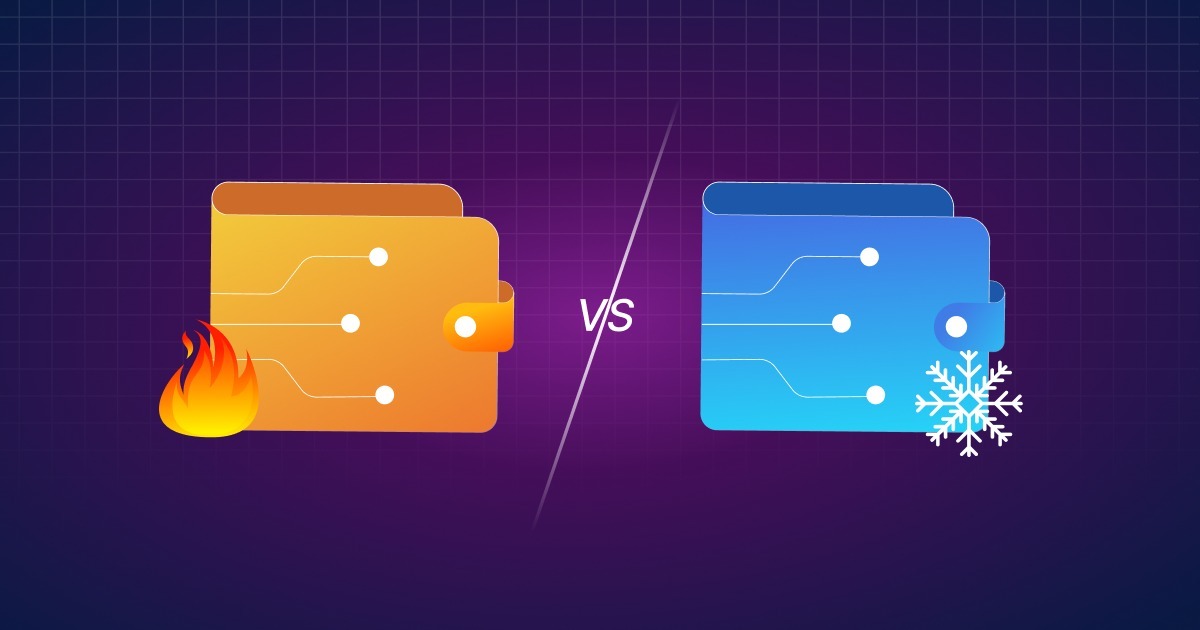In the world of cryptocurrencies, security is of paramount importance.
Two popular methods of storing digital assets are hot wallets and cold wallets.
Thus, understanding the key differences between these approaches is crucial for safeguarding one’s crypto holdings.
Exploring the distinctions between hot and cold wallets will enable crypto users to decide the most appropriate storage method for their digital assets.
What is a Hot Wallet?
A hot wallet is a type of cryptocurrency wallet that is connected to the internet. It is designed to provide convenient and immediate access to digital assets, allowing users to easily manage and transact with their cryptocurrencies.
Hot wallets can take various forms, including software-based wallets like mobile apps or desktop clients, as well as web-based wallets accessible through a browser.
One of the key characteristics of a hot wallet is its online connectivity.
Connecting to the internet lets users quickly send and receive cryptocurrencies, check their balances, and engage in real-time transactions. This accessibility makes hot wallets suitable for day-to-day use and frequent trading activities.
Hot wallets store the cryptographic keys required to access and manage the cryptocurrencies within the wallet. While this enables seamless transactions, it also introduces a potential security risk.
Since hot wallets are connected to the internet, they are more susceptible to hacking attempts, malware attacks, and other cyber threats. Malicious actors may target hot wallets to gain unauthorized access to the private keys and steal the stored cryptocurrencies.
To mitigate the security risks associated with hot wallets, it is essential to follow best practices such as using strong, unique passwords, enabling two-factor authentication, and regularly updating the wallet software.
It is also advisable to keep only a limited amount of funds in a hot wallet for immediate use, while storing most of the cryptocurrencies in a more secure offline storage method, such as a cold wallet.
What is a Cold Wallet?
A cold wallet, also known as a hardware wallet, is a type of cryptocurrency wallet that provides an offline and highly secure storage solution for digital assets.
Unlike hot wallets, which are connected to the internet, cold wallets store the private keys associated with cryptocurrencies offline, significantly reducing the risk of unauthorized access and hacking.
Cold wallets are typically physical devices, often resembling USB drives or small hardware devices. They are designed to generate and securely store private keys within the device. The private keys never leave the cold wallet, ensuring they are not exposed to potential online threats or vulnerabilities.
One of the key advantages of cold wallets is their enhanced security.
Cold wallets protect cryptocurrencies from hacking attempts, malware attacks, and other online threats by keeping private keys offline. Even if a cold wallet is connected to an infected computer, the private keys remain secure within the device, making it extremely difficult for hackers to gain access.
Using a cold wallet involves plugging the device into a computer or mobile device when a transaction needs to be authorized.
Once the transaction is confirmed and signed within the cold wallet, it generates a secure digital signature that can be broadcasted to the network. This offline-signing process ensures that the private keys remain secure and protected from potential online vulnerabilities.
Cold wallets offer peace of mind for the long-term storage of cryptocurrencies or for holding significant amounts of digital assets. They are a preferred choice for users who prioritize security and want to minimize the risk of their funds being compromised.
However, it’s important to store the backup of the cold wallet securely and follow proper procedures for recovery in case the device is lost or damaged.
Hot Wallet vs Cold Wallet: Key Differences
Below are the notable differences between hot and cold wallets.
1. Security
The key difference between hot and cold wallets is their security features.
Being connected to the internet, hot wallets are more susceptible to hacking attempts, malware attacks, and phishing scams. The online accessibility of hot wallets exposes them to potential vulnerabilities.
On the other hand, cold wallets, by storing private keys offline, provide an extra layer of security. They are less vulnerable to online threats as the private keys are not exposed to the internet, making it extremely difficult for hackers to gain unauthorized access.
2. Storage Method
Hot wallets are software-based or web-based wallets that store private keys on devices connected to the internet, such as computers, smartphones, or cloud storage.
In contrast, cold wallets are physical devices that store private keys offline. Cold wallets can be hardware wallets, USB drives, or dedicated offline storage devices. The offline storage method of cold wallets ensures that private keys are kept secure and isolated from potential online attacks.
3. Accessibility and Convenience
Hot wallets provide easy accessibility and convenience for day-to-day transactions. They allow users to quickly send and receive cryptocurrencies, check balances, and engage in real-time trading. Hot wallets are suitable for users requiring frequent digital asset access.
Cold wallets, while providing enhanced security, may be less convenient regarding accessibility. Transactions using cold wallets typically require connecting the physical device to a computer or mobile device to authorize and sign transactions. Cold wallets are more commonly used for long-term storage and securing significant amounts of cryptocurrencies.
Pros and Cons of Hot Wallets
Hot wallets come with several advantages and disadvantages.
Pros
Let’s start with the advantages of a hot wallet.
1. Convenience
Hot wallets offer convenient access to digital assets, allowing users to send, receive, and manage cryptocurrencies quickly. They are suitable for day-to-day transactions and frequent trading activities.
2. Real-time transactions
Hot wallets enable instant transactions, as they are connected to the internet and can interact directly with blockchain networks. This makes them ideal for users who require immediate liquidity and responsiveness.
3. User-friendly interfaces
Hot wallets often come with intuitive user interfaces, making them easy to navigate, even for beginners. They provide a familiar environment similar to online banking or e-wallet applications.
Cons
Let’s look into the disadvantages of a hot wallet.
1. Security risks
The primary drawback of hot wallets is their exposure to online security risks. They are more susceptible to hacking attempts, malware attacks, and phishing scams because they are connected to the internet.
Users must be cautious and take additional security measures to protect their funds.
2. Centralization of private keys
Hot wallets usually store private keys on centralized servers or with wallet providers. This centralization poses a risk as users rely on the security practices and infrastructure of the wallet provider.
3. Increased vulnerability
Hot wallets face the risk of device compromises, such as malware infections or unauthorized access to the device.
If a user’s computer or smartphone is compromised, the hot wallet’s security can also be compromised.
Pros and Cons of Cold Wallets
Let’s explore the pros and cons of using a cold wallet.
Pros
Let’s start with the advantages of a cold wallet.
1. Enhanced security
Cold wallets offer a higher security level than hot wallets. By storing private keys offline, they protect digital assets from hacking attempts, malware attacks, and online vulnerabilities.
The isolation from the internet significantly reduces the risk of unauthorized access or theft.
2. Protection against online threats
As cold wallets are not connected to the internet during regular use, they are immune to most online threats such as phishing scams or malware infections. This ensures that private keys remain secure and inaccessible to malicious actors.
3. Ownership and control
Cold wallets give users complete ownership and control over their private keys.
Users are not dependent on third-party entities for private key management. This decentralization allows for greater autonomy and reduces the risk of losing funds due to the failure or compromise of a wallet provider.
Cons
Let’s look into the disadvantages of a cold wallet.
1. Less convenient for frequent transactions
Cold wallets are generally less convenient for everyday transactions than hot wallets. They require physically connecting the device to a computer or mobile device to authorize and sign transactions.
This additional step can be cumbersome for users who require frequent access to their funds.
2. Cost
Cold wallets are physical devices, and some models can be relatively expensive compared to software-based hot wallets.
The cost of purchasing a cold wallet is an upfront investment that users must consider.
3. Potential physical loss or damage
Since cold wallets are physical devices, there is a risk of misplacing or damaging them.
If a cold wallet is lost or damaged without proper backup measures, it can result in the irreversible loss of the associated cryptocurrencies.
Conclusion
Hot wallets offer convenience and quick access for frequent transactions but carry a higher risk of potential hacks.
Cold wallets, on the other hand, prioritize security by storing private keys offline, but they may be less convenient for everyday transactions. Balancing accessibility and security is a personal decision that depends on an individual’s specific needs and risk tolerance.
Understanding the distinctions between hot wallets and cold wallets empowers crypto users to make informed choices and ensure the safety of their valuable digital assets.
FAQs
1. What is a hot wallet?
A hot wallet is a type of cryptocurrency wallet that is connected to the internet. It can be software-based, such as a mobile app or a desktop client, or web-based, accessible through a browser.
Hot wallets provide convenient access to digital assets, allowing users to send, receive, and manage their cryptocurrencies easily.
However, because they are connected to the internet, hot wallets are considered more susceptible to hacking and unauthorized access than cold wallets.
2. What is a cold wallet?
A cold wallet, a hardware wallet, is a physical device designed to store cryptocurrencies offline. It provides an extra layer of security by keeping private keys offline, away from potential online threats.
Cold wallets are typically in the form of USB-like devices that securely generate and store private keys. Since they are not connected to the internet during regular use, cold wallets offer a higher level of protection against hacking and malware attacks.
3. Which wallet is more secure: hot wallet or cold wallet?
Cold wallets are generally considered more secure than hot wallets. Because cold wallets store private keys offline, they are not vulnerable to online threats like hacking or phishing attacks. The isolation from the internet significantly reduces the risk of unauthorized access or theft of cryptocurrencies.
In contrast, hot wallets connected to the internet are more exposed to potential security breaches. However, it’s important to note that no wallet is completely immune to risks, and users should also consider factors like physical security and proper backup measures when determining the overall security of their cryptocurrency storage.




